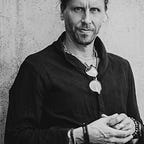EPISODE 5: EVERY ADVENTURE BEGINS IN THE SAME WAY
For weeks leading up to July 5th — the first day of TURNING LEFT — I’d been organising, shifting, stacking … sometimes piling only to then unpile. I was packing up my home, reducing it to labelled, brown boxes. On July 3rd all but me, two duffle bags and a sleeping bag were put into storage. That night, sitting in an empty abode, which friends knew as The Cove (as it was a safe place for pirates), I ate on the hardwood floor in silence in the amber glow of candles, fairy-lights and a fire. I slept there too … by choice.
Two days later, I left. Which quickly brings me to the point of this blog (Episode 5 of our Adventure Series).
All adventures begin in the same way: They begin with leaving.
Myself and Rich Clarke (who has been fundamental to the lab’s research for many years) studied the brain and behaviour of bumblebees. They are amazing! They can count to at least five. They can recognise human faces. And when they leave their homes for the first time, they do what you would do: They look back … by flying in increasingly large arcs while facing their ‘door’ as they move away from it. They are remembering.
We are no different. We too look back … and remember.
When packing up The Cove, one of the most significant tasks was ‘The Books’. There are hundreds. Prior to the movers coming, I had to take them down from shelves that towered 13 feet in order to be stored. I never throw a book away: I don’t understand how one could. Especially once read. Each is an adventure told … or soon to be told. The words on the page are only part of its adventure. Its living denouement is written in coffee stains, folds and in the margins in pen. Seeing its binding on the shelf is a bookmark in one’s life. The cafes, the landscapes and beds where it was read — and maybe with whom. Books are prescient; Their words find us when we need them. Dostoevsky’s imagination in The Brothers Karamazov was written on parchment. It has since been re-written in the axons and dendrites of the cells of my hippocampus, amygdala and cortex which encode the places, emotions and meanings of his imagination. But so too are the landscapes of San Francisco, my sister Krista’s home, and the pain of my (first) divorce 25 years ago where Dostoevsky’s words found me. Alyosha and Ashley are now forever woven together in my mind.
After closing the front door of this Cove for the last time, I got into my rented ragtop with my two duffle bags for company, and — like a bumblebee — looked back. I saw the meaning that lay behind its facade. I then realised that each facade on 11th street … just up from Jerry’s cleaners where my boys would deliver clothes by skateboard when visiting from England, and down from the corner shop whose wonderful owner held an extra key (just in case a friend — pirate — needed a place — cove — to hide) … is a spine of a book on a shelf with the story of its pages inside.
Looking back is why leaving is hard … because we know that it will require letting go. Throwing away the book.
Everything you do, see, know and believe is grounded in your assumptions and biases that are encoded in the structure of your brain. Some of them you authored. Most you didn’t. They were inherited through the past stories that have been projected onto you. A parent’s, a society’s or a culture’s trauma … or victory. Fears, triggers and beliefs, as well as values, when projected early in your life when your brain is most plastic, become blindly self-evident. They are your ‘intuitions’. Perceptual laws that you don’t question because you don’t even know they are there. When asked to explore them, the answer is usually … ‘Explore what?’ … … or simply … ‘NO!’. The ‘Physics of No’ is to treat one’s assumptions as objective, physical truths (like gravity), instead of what they really are: Subjective truths that might or might not have legitimacy … despite their legitimate feelings.
Which means that most of the assumptions and biases that shape who you are, you don’t even know you have. It’s why marketing surveys often fail, because people give answers that they think are true, or would like to be true. If you don’t believe me, let’s play a game. Let’s see if I can read your mind … right now … from a distance …
There are two shapes below. They do not have names. They are not circles, diamonds or squares. They have no meaning … or so it seems.
Now, I’m going to give you two sounds:
KIKI & BUBU
They also have no meaning (at least in the English language).
Now … as an independent, free-thinking person who knows yourself … tell me … which of the shapes is KIKI and which is BUBU?
I’m guessing you said that the shape on the left is BUBU and the one on the right is KIKI. If true, the question is why did you answer this way?
To continue reading, please go here …
